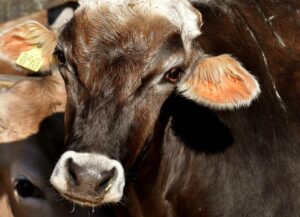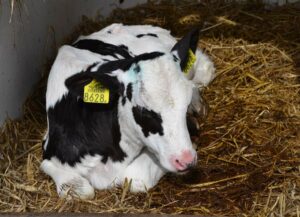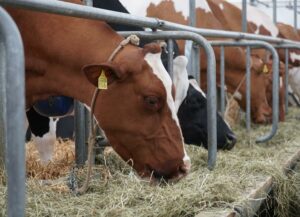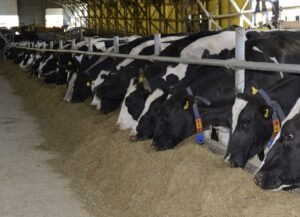Alvaro Garcia
Highly productive dairy cows are oftentimes challenged with high grain to forage ratios. These cows are oftentimes prone to subacute ruminal acidosis (SARA) and even the clinical form (acidosis), with animal well-being implications and a negative economic impact for the farm. These changes are the result of drops in the ruminal pH as its microbial population shifts towards groups that produce more propionate, and in turn lactate. Earlier research has found that 19 % of early lactation and 26 % of mid-lactation dairy cows suffer from SARA.
Clinical acidosis also increases the incidence of lameness, which is one of the most important causes of involuntary culling. One strategy to control SARA is to drench cows with Megasphaera elsdenii. This bacterium is very important to maintain rumen pH within acceptable limits, since it metabolizes lactate into propionate and acetate.
An experiment to study this intervention was recently published in Animal Feed Science and Technology (Mazon et al., 2020). The objective was to evaluate the effects of the oral drench of M. elsdenii on the reticulorumen pH, milk production and components, as well as the feeding behavior of lactating cows with SARA. Cows were considered in baseline conditions during the first 3 days of the experiment. On day 4 their feed was reduced by half of their usual average intake during the previous three days. On day 5 the cows were fed for two hours a diet rich in highly fermentable carbohydrates. The last 3 days were left for recovery. This was done on two trials with the only difference between both being the timing of drenching. In the first one the drench was four days before the SARA challenge (MEG4); in the second one, the day before (MEG1). Once finished with the first trial the treatments were reversed; each treatment was compared to a respective control group of cows (CON4 and CON1).
First Trial (MEG4; drench four days before SARA challenge)
Drenched cows had increased reticulorumen pH. When the pH threshold was set at 5.8, the area under the pH curve, and the time spent below this pH was reduced during the whole trial. This was also true when the threshold pH was set at 5.6. The MEG4 drench had a positive effect on reticulorumen pH, with greater pH on days -3, -1, +1, and +2. With the pH threshold set at 5.8, the area under the pH curve was reduced for MEG4 on days 0 and +1. Cows on CON4 spent more time below pH 5.8 on days -3, -2, -1, and +1. If the pH threshold was set at 5.6, then CON4 had increased area under the pH curve on days 0 and +1. Cows on CON4 also spent more time under pH 5.6 on day +1 and showed a trend to spend more time under pH 5.6 on day 0.
Cows on MEG4 had greater daily milk yields compared to controls. Milk protein concentration was also greater in these cows. Milk fat concentration on the other hand, tended to be lower compared to CON4 cows. CON4 cows also tended to have higher milk fat concentration on day 4. Milk protein concentration also tended to be greater for MEG4 cows on days -3, -1, and +2. This resulted in MEG4 having greater fat to protein ratio on day -1.
Second Trial (MEG1; drench one day before SARA challenge)
In the second trial MEG1 and CON1 drenches were administered on the fourth day of the trial, right when the cows had 50 % feed allowance and the day before the SARA challenge. Reticulorumen pH was unaffected by this treatment. When the pH threshold was set at 5.8 the area under the curve on MEG1 tended to be greater only on day +2. These cows also tended to spend less time below pH 5.6 on day +1 compared to the controls.
When looking at the entire experimental period for MEG1 cows, milk yield and components were not affected by this treatment. MEG1 cows however produced more milk on day 0 and showed a trend for more milk on day -3. CON1 cows had greater milk fat concentration on day 0. On the other hand, on day 0 MEG1 cows had greater milk protein concentration.
In summary, in the first trial, MEG4 cows produced more milk, with greater protein concentration and a reduced fat:protein ratio. These cows also had greater reticulorumen pH, shorter and less intense acidosis, and greater intake. In the second trial, MEG1 cows spent more time eating than the controls.
These results suggest the potential benefits of M. elsdenii on alkalinizing rumen pH, reducing acidosis, and possibly having a positive impact on milk yield and feed intake. The timing of the administration in order to obtain the maximum benefit from M. elsdenii drenching seems to also be important. There was no evidence to indicate that drenching cows with M. elsdenii affects feeding behavior.
Reference
Mazon, G., Campler, M.R., Holcomb, C., Bewley, J.M., Costa, J.H.C. 2020. Effects of a Megasphaera elsdenii oral drench on reticulorumen pH dynamics in lactating dairy cows under subacute ruminal acidosis challenge. Animal Feed Science and Technology. 114404.
© 2020 Dairy Knowledge Center. All Rights Reserved.









